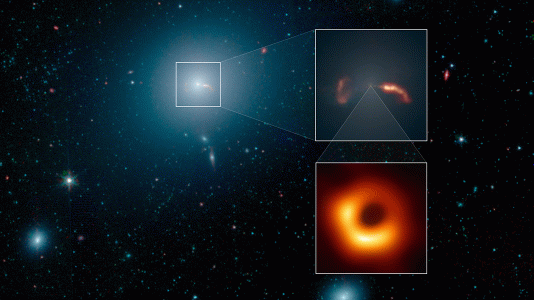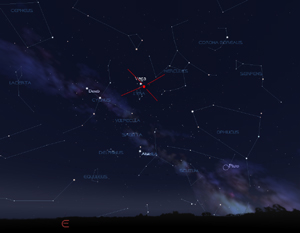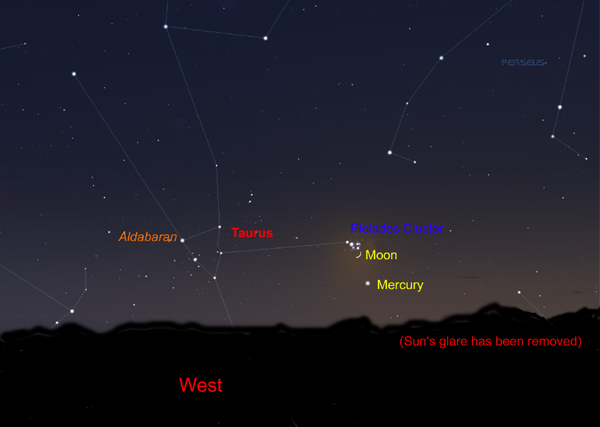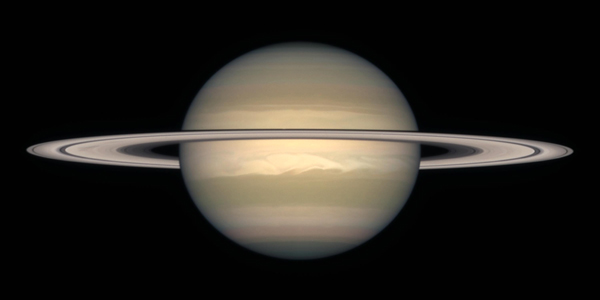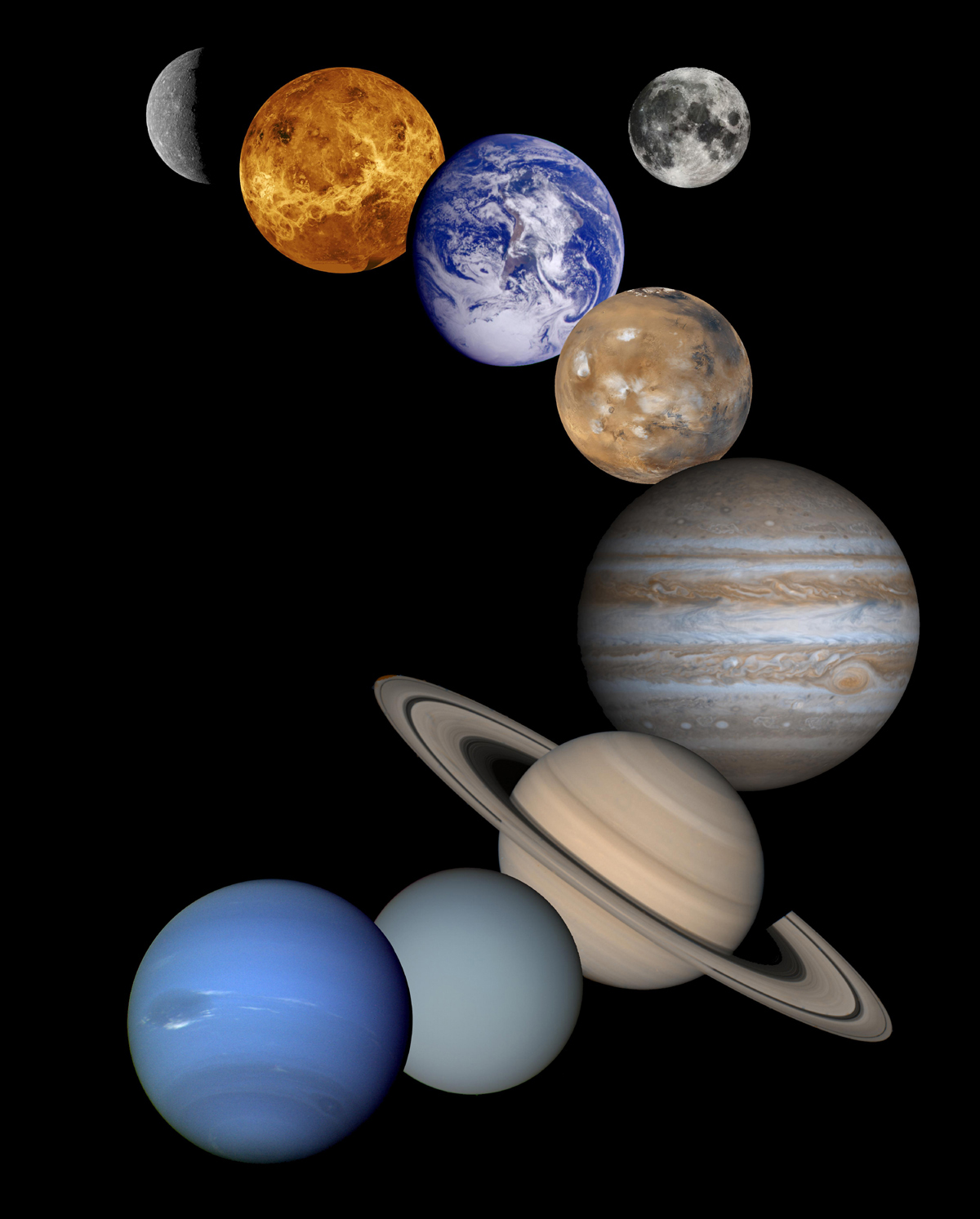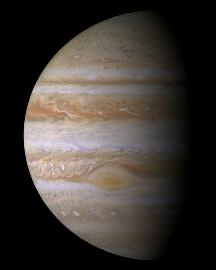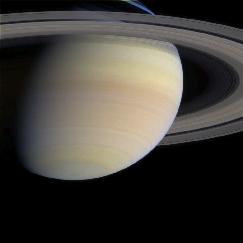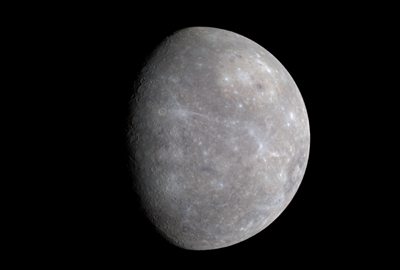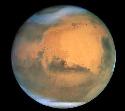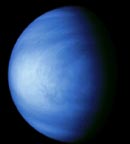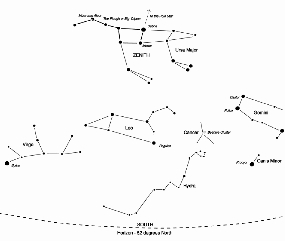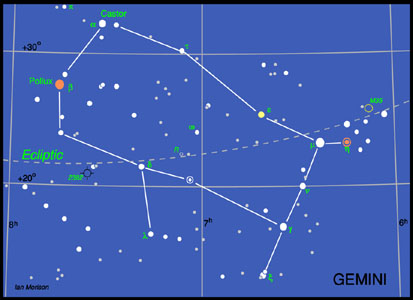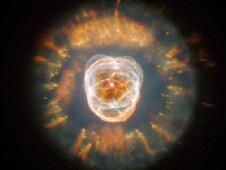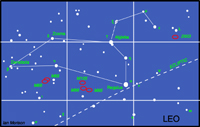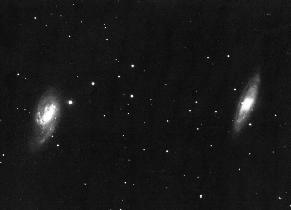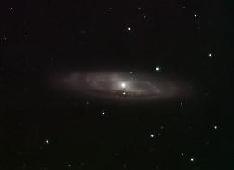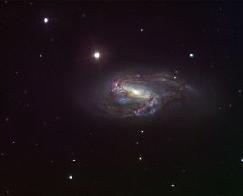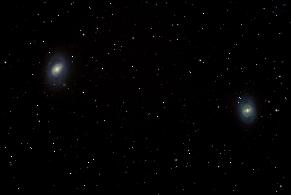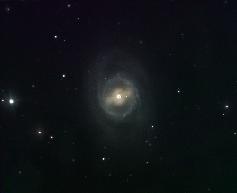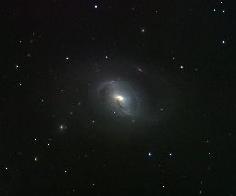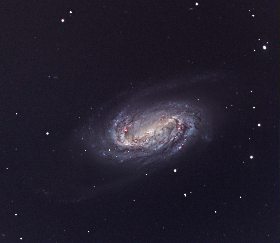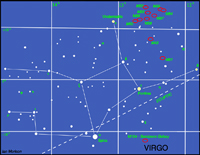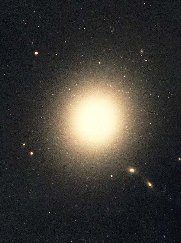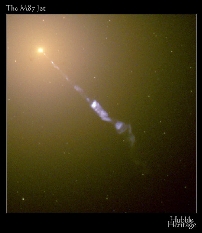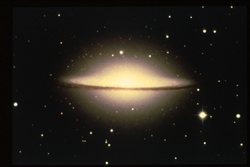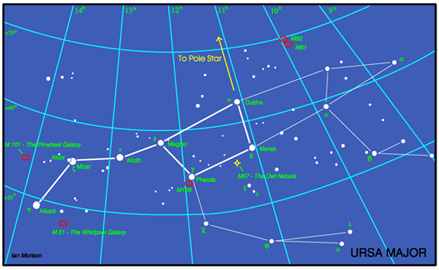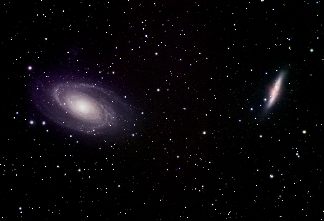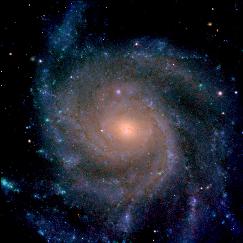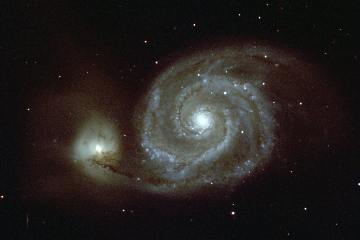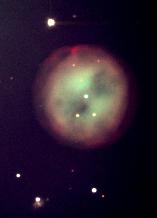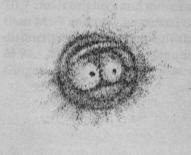The Night Sky April 2009
Compiled by Ian Morison
This page, updated monthly, will let you know some of the things that you can look out for in the night sky. It lists the phases of the Moon, where you will see the naked-eye planets and describes some of the prominent constellations in the night sky during the month.
Image of the Month
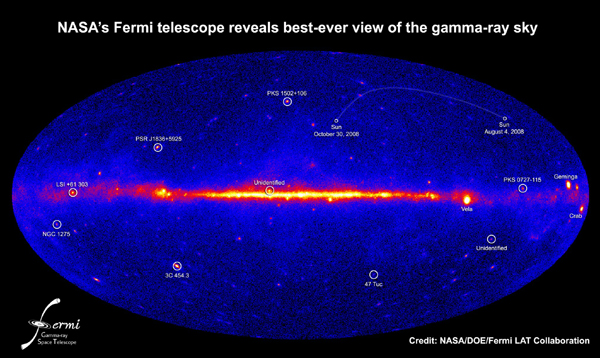
Fermi's Gamma-Ray Sky
Image: NASA, DOE, Fermi LAT Collaboration
This Gamma-Ray map of the whole sky was made using three months worth of data from the Fermi mission's Large Area Telescope. The photons recorded by this telescope are 50 million times more energetic that those of visible light! The map highlights five gamma-ray sources within out galaxy and five beyond:
1) The Sun, in the upper right, traces out its path from August 4th 2008 to October 30th 2008
2) The pulsar, a rotating neutron star, 1836+59.
3) The globular Cluster 47 Tucanae.
4) An X-Ray Binary star, LSI +61 303.
5) An unidentified variable source, not seen at other wavelength, upper right of the galactic centre.
6) NGC 1275 is a large galaxy at the heart of the Perseus Cluster, 233 million light years distant.
7-9) Three active galaxies that are billions of light years distant.
10) An unidentified source of gamma-rays below right of the galactic centre.
Highlights of the Month
The Lyrid meteor Shower on the night of 22/23rd April
The Lyrid Meteor Shower - so called as the radiant (from where the meteor trails seem to radiate from) lies in the constellation Lyra. It peaks in the early morning of the 22nd April and is a reliable, though not spectacular, shower with perhaps up to 15 meteors seen per hour. Observations of the Lyrid meteors have been made for at least 2,600 years! This year the peak of activity is just before new-moon, so the thin crescent waning Moon should not interfere with our observations. Observations made after midnight are expected to be more productive. The dust particles that cause the shower have been released by the comet Thatcher, discovered in 1861. Occasionally we pass through a dense clump of particles as happened in 1982 when over 90 meteors were seen per hour. So its worth waking up to have a look if clear around 1-2 am. Look to the East as shown in the chart.
April 26th: Mercury at greatest elongation and the Moon occults the Pleiades.
Mercury, at magnitude +0.1, reaches eastern elongation, when its angular distance from the Sun is greatest, on the 26th April. It is then 20 degrees from the Sun and will remain in the twilight sky for a further two hours after sunset. You will need a very low western horizon and its probably best to be there as the Sun in setting to see roughly where you will need to observe - to the upper right of setting Sun. After sunset you should be able to pick out Mercury with binoculars just 2 degrees below a thin, 41 hour old, waxing crescent Moon. DO NOT observe with binoculars until the Sun has set! Mercury will be well placed in the evening sky for several days either side of the 26th April, and its probably best to observe it about 1 hour after sunset. Later that evening the Moon will occult the Pleiades cluster and it is interesting watching its brightest stars dissapearing behind the dark limb of the Moon. From northern England, Merope will be occulted at 21:31 UT and reappear at 22:11 UT.
April: Saturn in the evening sky
To see some of Damian Peache's Saturn Images: Damian Peache's website
Saturn is now high in the southern sky during the evening lying in the constellation of Leo. Saturn lies well below the body of Leo some 8 degrees below the star Theta Leonis. It starts the month at magnitude +0.6 with an angular size of ~19.5 arc seconds and these fall to +0.7 and 19.1 as the month progresses. Saturn is significantly less bright this year than it sometimes is: the rings are very close to edge on (as shown in the Hubble image of Saturn) and thus there is less apparent reflecting area. The rings will be seen (or rather - not seen) edge-on later this year and it will not be until 2016 that they will be at their widest again. A small telescope will easily show its largest moon, Titan, and show some bands around the surface.
Observe the International Space Station
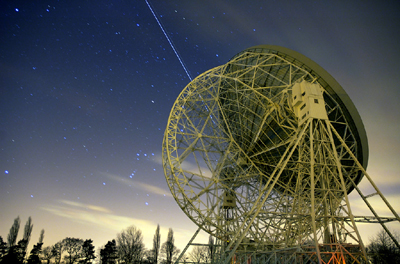
The International Space Station and Jules Verne passing behind the Lovell Telescope on April 1st 2008.
Image by Andrew Greenwood
Use the link below to find when the space station will be visible in the next few days. In general, the space station can be seen either in the hour or so before dawn or the hour or so after sunset - this is because it is dark and yet the Sun is not too far below the horizon so that it can light up the space station. As the orbit only just gets up the the latitude of the UK it will usually be seen to the south, and is only visible for a minute or so at each sighting. Note that as it is in low-earth orbit the sighting details vary quite considerably across the UK. The NASA website linked to below gives details for several cities in the UK. (Across the world too for foreign visitors to this web page.)
Note: I observed the ISS three times in the last week or so of July and was amazed as to how bright it has become.
Find details of sighting possibilities from your location from: Location Index
See where the space station is now: Current Position
The Moon
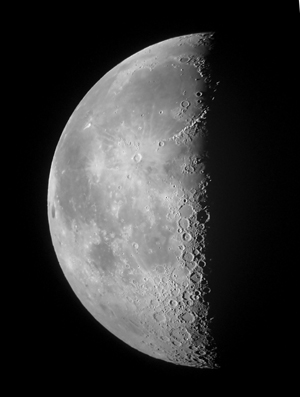
The Moon at 3rd Quarter. Image, by Ian Morison, taken with a 150mm Maksutov-Newtonian and Canon G7.
Just below the crator Plato seen near the top of the image is the mountain "Mons Piton". It casts a long shadow across the maria from which one can calculate its height - about 6800ft or 2250m.
| new | first quarter | full moon | last quarter |
|---|---|---|---|
| April 25th | April 2nd | April 9th | April 17th |
Some Lunar Images by Ian Morison, Jodrell Bank Observatory: Lunar Images
The Planets
Jupiter
Jupiter is not easily visible this month as, though its seperation from the Sun is increasing in the pre-dawn sky, its elevation is still very low as the ecliptic is at a shallow angle to the horizon in springtime. During April its separation from the Sun increases from 45 degree to 77 degrees, and with a magnitude slowly increasing from -2.1 to -2.2, might be glimpsed very low in the south-east just before dawn. Even at the end of the month it will still be only be ~17 degrees above the horizon so binoculars may well be needed. It will lie close the the waning crescent Moon on the 19th (to the left of the Moon) and 20th (to its right). Better wait a month or so!Saturn
Saturn see highlight above.
Mercury
Mercury: see highlight above.
Mars
Mars is still close in angle to the Sun (just 28 degrees as April begins) so will be very hard to spot in the pre-dawn sky having a magnitude of +1.2. By the end of the month, the angular seperation has increased to 34 degrees which helps, but as the ecliptic makes such a small angle to the horizon that Mars will then be just 8 degrees above the horizon as the Sun rises. We will have to wait a month or so until it will be seen easily in the pre-dawn sky.
Venus
Venus passed betwen the Earth and Sun in March so, as April begins, is appearing in the pre-dawn sky. It will only lie 8 degrees above the horizon as the Sun rises on the first of April, so is unlikely to be spotted until later in the month. But even by the end of April it will only lie 13 degrees above the horizon at dawn so we will not see it in the way we were able to in January and February! It is at magnitude -4.6 at mid month.
Find more planetary images and details about the Solar System: The Solar System
The Stars
The mid evening April Sky
This map shows the constellations seen in the south in mid-evening.
The constellation Gemini is now setting towards the south-west and Leo holds pride (sic) of place in the south with its bright star Regulus. Between Gemini and Leo lies Cancer. Close to the boundary of these two constellation is where, this month, the planet Saturn may be found. It is well worth observing with binoculars to see the Beehive Cluster at its heart. Below Gemini is the tiny constellation of Canis Minor whose only bright star is Procyon. Rising in the south-east is the constellation Virgo whose brightest star is Spica. Though Virgo has few bright stars it is in the direction of of a great cluster of galaxies - the Virgo Cluster - which lies at the centre of the supercluster of which our local group of galaxies is an outlying member. The constellation Ursa Major is high in the northern sky during the evening this month and contains many interesting objects.
The constellation Gemini
Gemini - The Twins - lies up and to the left of Orion and is in the south-west during early evenings this month. It contains two bright stars Castor and Pollux of 1.9 and 1.1 magnitudes respectivly. Castor is a close double having a separation of ~ 3.6 arc seconds making it a fine test of the quality of a small telescope - providing the atmospheric seeing is good! In fact the Castor system has 6 stars - each of the two seen in the telescope is a double star, and there is a third, 9th magnitude, companion star 73 arcseconds away which is alos a double star! Pollux is a red giant star of spectral class K0. The planet Pluto was discovered close to delta Geminorum by Clyde Tombaugh in 1930. The variable star shown to the lower right of delta Geminorum is a Cepheid variable, changing its brightness from 3.6 to 4.2 magnitudes with a period of 10.15 days
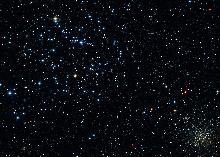
M35 and NGC 2158
This wonderful image was taken by Fritz Benedict and David Chappell using a 30" telescope at McDonal Observatory. Randy Whited combined the three colour CCD images to make the picture
M35 is an open star cluster comprising several hundred stars around a hundred of which are brighter than magnitude 13 and so will be seen under dark skies with a relativly small telescope. It is easily spotted with binoculars close to the "foot" of the upper right twin. A small telescope at low power using a wide field eyepiece will show it at its best. Those using larger telescopes - say 8 to 10 inches - will spot a smaller compact cluster NGC 2158 close by. NGC 2158 is four times more distant that M35 and ten times older, so the hotter blue stars will have reached the end of their lives leaving only the longer-lived yellow stars like our Sun to dominate its light.
To the lower right of the constellation lies the Planetary Nebula NGC2392. As the Hubble Space Telescope image shows, it resembles a head surrounded by the fur collar of a parka hood - hence its other name The Eskimo Nebula. The white dwarf remnant is seen at the centre of the "head". The Nebula was discovered by William Herschel in 1787. It lies about 5000 light years away from us.
The constellation Leo
The constellation Leo is now in the south-eastern sky in the evening. One of the few constellations that genuinely resembles its name, it looks likes one of the Lions in Trafalger Square, with its main and head forming an arc (called the Sickle) to the upper right, with Regulus in the position of its right knee. Regulus is a blue-white star, five times bigger than the sun at a distance of 90 light years. It shines at magnitude 1.4. Algieba, which forms the base of the neck, is the second brightest star in Leo at magnitude 1.9. With a telescope it resolves into one of the most magnificent double stars in the sky - a pair of golden yellow stars! They orbit their common centre of gravity every 600 years. This lovely pair of orange giants are 170 light years away.
Leo also hosts two pairs of Messier galaxies which lie beneath its belly. The first pair lie about 9 degrees to the west of Regulus and comprise M95 (to the east) and M96. They are almost exactly at the same declination as Regulus so, using an equatorial mount, centre on Regulus, lock the declination axis and sweep towards the west 9 degrees. They are both close to 9th magnitude and may bee seen together with a telescope at low power or individually at higher powers. M65 is a type Sa spiral lying at a distance of 35 millin klight years and M66, considerably bigger than M65, is of type Sb. Type Sa spirals have large nuclei and very tightly wound spiral arms whilst as one moves through type Sb to Sc, the nucleus becomes smaller and the arms more open.
The second pair of galaxies, M95 and M96, lie a further 7 degrees to the west between the stars Upsilon and Iota Leonis. M95 is a barred spiral of type SBb. It lies at a distance of 38 million light years and is magnitude 9.7. M96, a type Sa galaxy, is slightly further away at 41 million light years, but a little brighter with a magnitude of 9.2. Both are members of the Leo I group of galaxies and are visible together with a telescope at low power.
There is a further ~9th magnitude galaxy in Leo which, surprisingly, is in neither the Messier or Caldwell catalogues. It lies a little below lambda Leonis and was discovered by William Herschel. No 2903 in the New General Catalogue, it is a beautiful type Sb galaxy which is seen at somewhat of an oblique angle. It lies at a distance of 20.5 million light years.
The constellation Virgo
Virgo, rising in the east in late evening this month, is not one of the most prominent constellations, containing only one bright star, Spica, but is one of the largest and is very rewarding for those with "rich field" telescopes capable of seeing the many galaxies that lie within its boundaries. Spica is, in fact, an exceedingly close double star with the two B type stars orbiting each other every 4 days. Their total luminosity is 2000 times that of our Sun. In the upper right hand quadrant of Virgo lies the centre of the Virgo Cluster of galaxies. There are 13 galaxies in the Messier catalogue in this region, all of which can be seen with a small telescope. The brightest is the giant elliptical galaxy, M87, with a jet extending from its centre where there is almost certainly a massive black hole into which dust and gas are falling. This releases great amounts of energy which powers particles to reach speeds close to the speed of light forming the jet we see. M87 is also called VIRGO A as it is a very strong radio source.
Below Porrima and to the right of Spica lies M104, an 8th magnitude spiral galaxy about 30 million light years away from us. Its spiral arms are edge on to us so in a small telescope it appears as an elliptical galaxy. It is also known as the Sombrero Galaxy as it looks like a wide brimmed hat in long exposure photographs.
The constellation Ursa Major
The stars of the Plough, shown linked by the thicker lines in the chart above, form one of the most recognised star patterns in the sky. Also called the Big Dipper, after the soup ladles used by farmer's wives in America to serve soup to the farm workers at lunchtime, it forms part of the Great Bear constellation - not quite so easy to make out! The stars Merak and Dubhe form the pointers which will lead you to the Pole Star, and hence find North. The stars Alcor and Mizar form a naked eye double which repays observation in a small telescope as Mizar is then shown to be an easily resolved double star. A fainter reddish star forms a triangle with Alcor and Mizar.
Ursa Major contains many interesting "deep sky" objects. The brightest, listed in Messier's Catalogue, are shown on the chart, but there are many fainter galaxies in the region too. In the upper right of the constellation are a pair of interacting galaxies M81 and M82 shown in the image below. M82 is undergoing a major burst of star formation and hence called a "starburst galaxy". They can be seen together using a low power eyepiece on a small telescope.
Another, and very beautiful, galaxy is M101 which looks rather like a pinwheel firework, hence its other name the Pinwheel Galaxy. It was discovered in1781 and was a late entry to Messier's calalogue of nebulous objects. It is a type Sc spiral galaxy seen face on which is at a distance of about 24 million light years. Type Sc galaxies have a relativly small nucleus and open spiral arms. With an overall diameter of 170,000 light it is one of the largest spirals known (the Milky Way has a diameter of ~ 130,000 light years).
Though just outside the constellation boundary, M51 lies close to Alkaid, the leftmost star of the Plough. Also called the Whirlpool Galaxy it is being deformed by the passage of the smaller galaxy on the left. This is now gravitationally captured by M51 and the two will eventually merge. M51 lies at a distance of about 37 million light years and was the first galaxy in which spiral arms were seen. It was discovered by Charles Messier in 1773 and the spiral structure was observed by Lord Rosse in 1845 using the 72" reflector at Birr Castle in Ireland - for many years the largest telescope in the world.
Lying close to Merak is the planetary nebula M97 which is usually called the Owl Nebula due to its resemblance to an owl's face with two large eyes. It was first called this by Lord Rosse who drew it in 1848 - as shown in the image below right. Planetary nebulae ar the remnants of stars similar in size to our Sun. When all possible nuclear fusion processes are complete, the central core collpses down into a "white dwarf" star and the the outer parts of the star are blown off to form the surrounding nebula.

